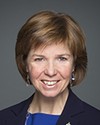I know you can't. This is probably the million-dollar problem.
The biggest issue we face as an organization is the challenges with the various provincial educational systems. As you would all know, where there isn't any jurisdiction federally, the biggest problem is getting consistency in the educational programming and making sure that it's being used. We work with all the provinces and territories in doing that. It is a very significant challenge. What a family in Quebec may expect is going to be very different from what a family in British Columbia expects, depending on the lay of the land. That is very significant.
We have no issue getting people at the table. We have no issue in terms of getting people to step up and want to get behind the work we're doing. The challenge at the end is really how we are touching every Canadian in a way that's meaningful for them, in a way that's valuable, and in a way that's making a difference in how they're able to parent and how they're able to protect their children.
We are always looking at legislative changes. We have a federal action plan that we tabled last year and we're happy to send it to anyone. It's on our website and it asks for concrete legislative steps.
The biggest thing is at the end of the day is that the most important people around a child have the opportunity to protect that child, to disrupt or uncover anything that's getting in their way to either hurt them or take away some avenue of protection. How do we do that public awareness? In a way, as I mentioned, having that touch point is probably the most significant thing. At the end of the day, though, we do believe educators in schools, who are with kids every single day, have a very significant role, and we haven't completely figured that one out in terms of how we make sure every child in Canada is getting that type of education.



